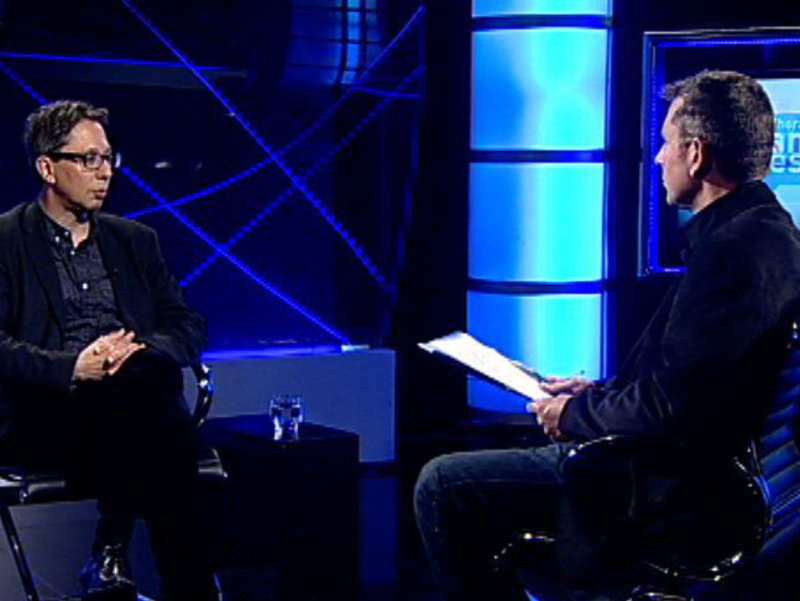Interview
A place in the world of art
Ferran Barenblit Every Friday afternoon on El Punt Avui Televisió, Barney chats with an English-speaking expat. For this month's interview he talks to the director of the Macba art gallery, Ferran Barenblit.
W
hat's the story behind your surname?
I was born in Buenos Aires, and moved here in 1977 when I was eight. When I was a teenager I translated my name into Catalan, one of the reasons was that when people saw my name in Spanish they would address me only in Spanish.
Your family left Buenos Aires to escape dictatorship. Do you have memories of that?
Very clear ones. The '70s were very difficult times in all Latin America. Fortunately, we found a home in Barcelona and we were extremely welcome here.
Do you ever go back?
Yes, sometimes. But every time I go it is a very intense and emotional experience. Identity is something that you cook very slowly.
Before coming to Barcelona you spent three years in New York and seven in Madrid.
When I finished studying art history here, I went to New York to study museum studies, and then I was lucky enough to get my first museum job there at the New Museum. Later, in 2008, in Madrid, I was offered the directorship of the Centro de arte 2 de mayo.
Have you always been fond of contemporary art?
I didn't see it as a vocation, but I've been very lucky. When I finished my degree, I got a great job, which was assisting a photographer, Leopold Samsó, to take photos for artists' catalogues, a job I think now doesn't exist any more, but which was important at the time. And I was very lucky because that way I had access to artists' studios. And I found out that there were also living artists, not just artists from the Middle Ages, the Renaissance or Baroque, which is what I had studied. That job gave me an understanding of what contemporary art meant in a moment when it wasn't what we have now; there were no museums of contemporary art, just the Miró Foundation. That was when I decided I wanted to work in a museum.
Any tips for those who want to do this type of work?
That your talent is always needed, the second tip is that there are no great recipes to be a curator: just curate, anywhere. In the '80s curators started doing shows in their apartments. Hans Ulrich did shows on his own fridge. You need information, positioning, and courage.
Do you choose all your shows?
A museum shouldn't be about the director's personal taste. My pesonal taste might not fill a museum as big as Macba. It's about collective decisions; what the museum has to be is something decided with the council.
Macba has just celebrated its 20th anniversary, last November.
My first day in this position was October 1, and this gave me a great opportunity to think about the next 20 years. My question is how the museum will look in 2035. It is a very political question, museums are very political places. They are also institutional labs in which we imagine the world in the future.
What exhibitions has Macba got on at the moment?
A show by José Antonio Hernández-Díez, a Venezuelan artist living in Barcelona; then American artist Andrea Fraser, who practises institutional critique. In May we've got the show Punk. Its Traces in Contemporary art. It's not a show about music or about people's hair, but it's about cultural revolution.
The Macba also runs educational programmes.
They are very intense and varied and we plan to make them more intense in the future. We have programmes for schools, families and adults (www.macba.cat). I would say that almost every day there is something different. I also recommend shows of Macba's own collections to visitors. Macba is also a collector and we have about 6,000 works at the moment, ranging from the second half of the 20th to the 21st century. And finally, we have three more solo shows, one by Miralda, a conceptual Catalan artist who was very well-known for his work related to food. This is a very ambitious exhibition, mostly about his work in America in the '70s. Then another solo show by Lebanese artist Akram Zaatari, about how to create a collective memory via images. And finally, another show which looks into the decade of the'80s.
Nowadays we are bombarded with images. Is that a help or more of a hindrance?
It's just a reality. Somebody said that in one year we generate more images than in the whole history of humanity before, and I think that gives a great opportunity to art, because most of the information we receive is via images.
What are the main challenges you face as director of a contemporary art museum?
Being insignificant, doing work that makes our lives a bit more intense: “Art is what makes life more interesting than art.”
Leave a comment
Sign in.
Sign in if you are already a verified reader.
I want to become verified reader.
To leave comments on the website you must be a verified reader.
Note: To leave comments on the website you must be a verified reader and accept the conditions of use.

